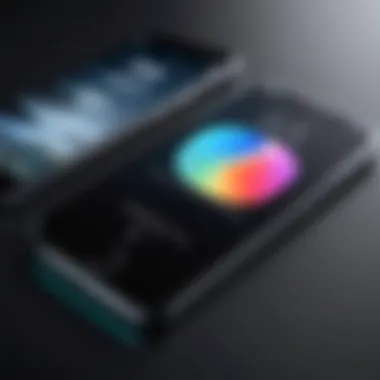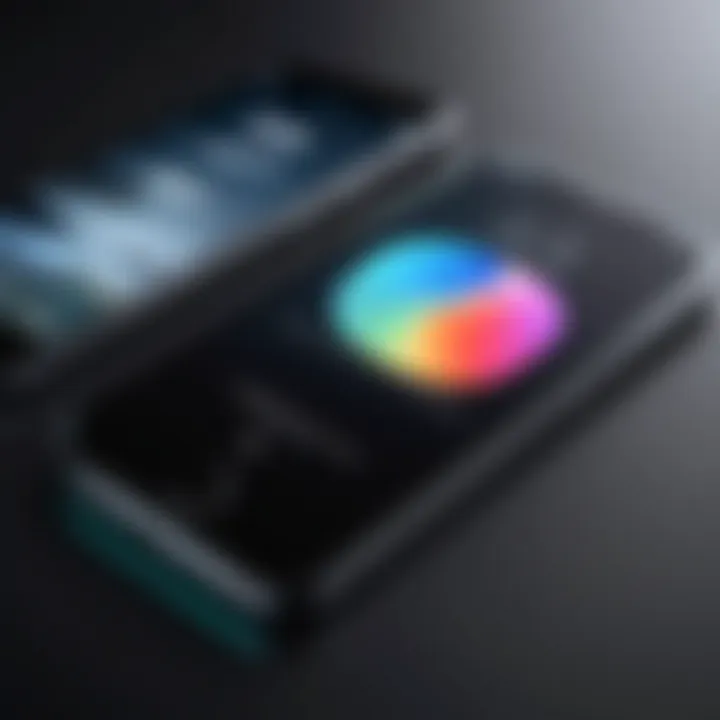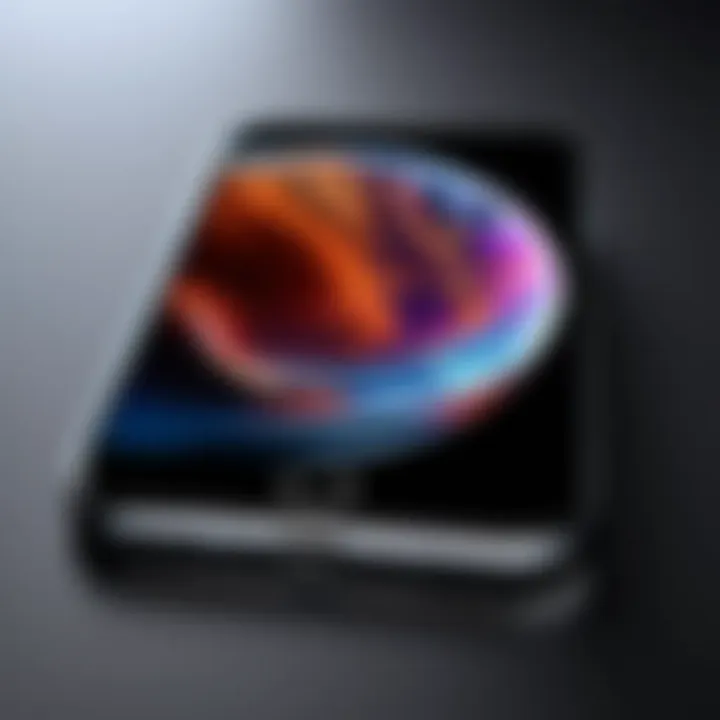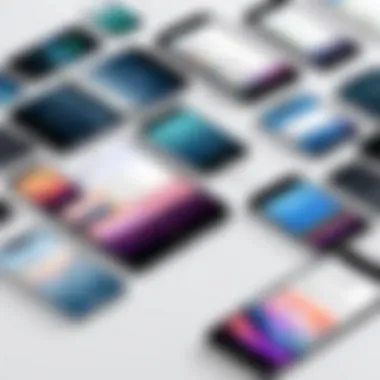Anticipating the Next iPhone Update: Insights and Trends


Intro
With the incessant evolution of technology, especially within the mobile landscape, it's no surprise that anticipation around the next iPhone update stirs curiosity. Each new release from Apple doesn’t merely signify a new device but serves as a benchmark in innovation, enticing gadget lovers and tech aficionados alike. This thorough investigation aims to explore what is ahead for the iPhone, analyzing expected features, insights from industry experts, and the typical rhythm of Apple's release cycle.
Understanding the forthcoming updates isn’t just following the latest trends; it’s about grasping the impact these changes can have across the tech landscape. As the company holds a significant sway in shaping consumer technology, the implications of these updates ripple far and wide, touching not only Apple users but also competitors and accessory makers.
In this article, we will dive deep into a comprehensive analysis of expected features and the nuances of design improvements that may influence your next iPhone purchase decision. Whether you are an early adopter or just a curious observer of tech, this exploration serves up a rich blend of insights designed for informed anticipation.
Historical Context of iPhone Updates
Understanding the historical context of iPhone updates is crucial when considering future enhancements or changes. It illuminates how Apple has navigated through technological advancements, user demands, and competitive pressures. By analyzing previous update cycles, we gain insight into how Apple tends to react to both market trends and customer feedback. This background not only highlights Apple's commitment to innovation but also lays the groundwork for anticipating what’s next.
The Evolution of iPhone Releases
Since the initial launch of the iPhone in 2007, Apple has meticulously crafted its release strategy. Each new model has introduced something novel, whether a hardware improvement, a software advancement, or both. For instance, the introduction of the App Store in 2008 marked a seismic shift in how applications were distributed and monetized, creating a thriving ecosystem.
- 2007: iPhone 1 - The device that started it all, which combined a phone, an iPod, and an Internet communicator.
- 2010: iPhone 4 - Featured Retina display and front-facing camera, elevating mobile photography.
- 2017: iPhone X - Introduced Face ID, eliminating the home button and marking the beginning of a new design era.
These examples highlight a pattern where Apple doesn’t just update for the sake of it, but rather tailors innovations to meet evolving consumer expectations. Each release adds another layer to the iPhone legacy, and with every iteration, Apple tends to emphasize design, functionality, and user experience.
Key Milestones in iPhone Development
Several key milestones in iPhone development stand out as crucial turning points.
- App Store Launch (2008): Revolutionized how software was consumed on mobile devices. Developers flocked to create applications, which transformed the iPhone into a vital productivity tool.
- Voice Control (2010): Allowed users to interact with their iPhones in a new way, paving the way for future voice assistants.
- 5G Capability (2020): With the iPhone 12, Apple embraced the next generation of connectivity, preparing its users for faster data speeds and improved performance.
These milestones showcase how Apple consistently integrates user feedback into its development strategy. From enhancing usability to addressing technological trends, it’s clear the company is always looking ahead.
Remember: The lessons learned from past releases not only inform Apple’s decisions but also shape consumer expectations. Companies don’t operate in a vacuum; there’s always a back-and-forth between what corporations unveil and what users demand.
As we gear up for the upcoming iPhone update, reflecting on this extensive history makes it easier to speculate what the next version might bring.
Understanding Apple's Release Patterns
Grasping the rhythm of Apple's release patterns is crucial for tech enthusiasts seeking to anticipate updates, especially about new iPhone models. This knowledge not only provides insights into when to expect innovations but also helps decode the rationale behind Apple's decisions. Understanding these timelines can optimize user experience, allowing consumers to plan tech acquisitions strategically.
By observing past patterns, loyal Apple users can forecast potential features, which can range from minor tweaks to game-changing advancements. Moreover, knowing release rhythms can influence users’ purchasing decisions, thus encouraging readiness for pre-orders or even reconsidering current device usage based on expected upgrades.
Typical Timelines for New Versions
Apple typically adheres to a predictable schedule in launching its products, particularly iPhones. Generally, new versions are announced every September. This timeline has become a sort of ritual for fans and can be succinctly observed in the form of:
- Announcement in Early September: The stage is set with an event wherein Apple unveils the newest addition to the iPhone family.
- Pre-orders Open a Week Later: Following the announcement, pre-orders typically commence within a few days, allowing eager buyers to secure their devices.
- Launch Date Usually Falls Late September: The official launch usually follows a week after pre-orders begin, aligning with the routine Apple has established through the years.
This pattern has been visible since the iPhone 5's launch, which set the tone for future models. Such a consistent timeline forms a predictable cycle for both consumers and industry analysts alike.
Influences on Release Schedules
A variety of factors can sway Apple's release schedules, creating fluctuations in the otherwise predictable cycle. Market dynamics, competitor actions, and technological advancements play pivotal roles in determining the actual timing of updates. Here are some key influences that continuously reshape Apple’s launch strategies:
- Market Demand: If consumer interest shifts towards specific features—like improved camera systems or enhanced battery life—Apple may prioritize those enhancements in their upcoming products, possibly influencing the timing.
- Supply Chain Dynamics: External factors, such as component availability or global supply issues, may cause delays. For instance, the COVID-19 pandemic introduced significant variances to the normal production schedules, prompting Apple to alter its release plans.
- Competitive Pressure: Rival brands often strategize around Apple’s timeline, launching their products to capitalize on the buzz created by the iPhone. This competitive landscape can sometimes push Apple to accelerate or postpone its releases to maintain relevance.
- Technological Breakthroughs: Should an innovation emerge that could significantly elevate the user experience, Apple might hastily adapt its release schedule to include these game-changing features sooner rather than later.
Understanding these intricacies can provide a roadmap for predicting the next iPhone update, empowering users to make informed decisions well in advance.
Anticipated Features of the Upcoming Update
The excitement surrounding every new iPhone release often hinges on the anticipated features that Apple is set to roll out. This topic holds critical importance in the realm of consumer electronics as it shapes buyer expectations and influences the market at large. When Apple announces an update, all eyes are on the new hardware, software, and design changes that could redefine the user experience. By diving deeper into these anticipated updates, we gain insights not only into what may come next but also into how these iterations reflect broader industry trends and consumer needs.
Hardware Upgrades
When it comes to hardware upgrades, Apple tends to push the envelope, ensuring that the latest devices incorporate advancements in technology that enhance performance. There are several areas where improvements are expected to be made in the upcoming update.
First, the processor is usually the crown jewel of any new iPhone. With each iteration, Apple has aimed to increase speed and efficiency. The speculation suggests that the next iPhone might feature the A17 Bionic chip, which promises better performance while being more power-efficient—essential for tasks like gaming and video editing.
Next, the camera system is another focal point. Many anticipate that enhancements to low-light performance, improved optical zoom capabilities, and possibly even higher megapixel counts could be introduced. Mobile photography has become a cornerstone for smartphone users, making this upgrade critical for capturing life's moments with clarity.
Moreover, battery life is always a hot-button topic. Users expect iPhones that can keep up with their busy lifestyles without needing constant recharging. Apple might address this with larger batteries or better power management features that extend usage times.
In addition, the inclusion of 5G connectivity enhancements is on the radar. As mobile networks continue to evolve, having a device that fully supports the latest standards is increasingly vital for consumers.


Software Improvements
Software updates tend to carry just as much weight as hardware changes, if not more. They often bring forth new capabilities that can extend the device's functionality well beyond the initial purchase.
One significant area of focus is the introduction of iOS updates. The next version is expected to come packed with features that improve user adaptability and convenience. For example, themes that allow personalized aesthetics and better privacy controls could resonate well with today's privacy-conscious consumers.
Another anticipated software improvement is in artificial intelligence capabilities. Features like more accurate predictive text, advanced voice recognition, and smarter camera functionalities are on the horizon. This could mean that the iPhone will learn from user habits, streamlining tasks and creating a more seamless experience.
Additionally, the integration of augmented reality (AR) functionalities is likely to see a boost. As developers increasingly adopt AR in applications, Apple's hardware and software are expected to synergize more effectively, catering to both fun and practical applications for end users.
Design Changes
Design changes play a pivotal role in how consumers perceive and interact with their devices. Even minor tweaks can generate significant buzz, which can translate into sales. While Apple has maintained a consistent design language across its devices, fresh updates are often a welcomed element.
One of the most debated design aspects is the display size and quality. Many believe that Apple may enhance the display technology in the upcoming iPhone, perhaps introducing ProMotion technology for smoother scrolling and interaction. This feature, which was previously limited to higher-end models, might trickle down to more accessible options.
Furthermore, the overall aesthetic is likely to endure some transformation. Rumors suggest a return to certain design elements reminiscent of classic models, integrating nostalgia into modern functionality. User feedback from social media also indicates a demand for new color options and finishes, which might reflect the personal style of more users.
Lastly, there is ongoing speculation about the port and button layout. While Apple has leaned towards a portless design, it’s likely that the next iPhone will balance between innovation and the traditional features that a vocal segment of users still appreciates.
The anticipation of the next iPhone update is not just about what will be released. It's about understanding how these features articulate Apple's vision for the future in the technology ecosystem.
Overall, the anticipated features of the upcoming iPhone update are not merely technical specifications, but rather an extension of Apple’s commitment to enhance the user experience through innovation. As tech-savvy individuals wait in eager anticipation, understanding these features can significantly influence purchasing decisions and foster a deeper connection with the product.
Market Trends Impacting the Update
When it comes to anticipating the next iPhone update, understanding market trends is crucial. This section dives into how evolving consumer demands and competitive dynamics shape Apple's strategy, making it essential for tech enthusiasts to grasp these factors to better predict what's on the horizon for the next iPhone release.
Consumer Demands and Innovations
Consumers today are not just looking for a phone; they want a complete package that syncs seamlessly with their lifestyle. The shift towards eco-friendliness, for instance, is influencing how companies approach product design and materials. Apple, being a frontrunner in innovative technology, is highly responsive to such consumer sentiments.
Recent trends indicate that users are particularly interested in features like enhanced battery life, advanced camera capabilities, and integration with smart home devices. Surveys reveal that 70% of users prioritize camera performance when considering a new phone. This points toward the potential introduction of superior optical technology and computational photography in the next iPhone. Additionally, there’s a growing demand for 5G capabilities. As networks continue to evolve, users expect their devices to keep pace with breakthroughs in speed and connectivity.
Moreover, personalized experiences powered by AI are becoming a significant draw. Techniques such as facial recognition and augmented reality have transformed how users interact with their devices, and Apple's likely to amplify these features in future updates.
- Increased emphasis on:
- Eco-friendly materials
- Photography enhancements
- 5G network capabilities
- AI-driven personalization
Competitor Strategies
Apple doesn't exist in a vacuum; it operates in a highly competitive smartphone market. The strategies employed by competitors can heavily influence Apple's decisions regarding the next update. Players like Samsung, Google, and OnePlus are constantly pushing boundaries, which in turn shapes consumer expectations.
Samsung, for instance, has recently focused on foldable technology, catering to a segment of users eager for innovative designs. If this trend gains traction, Apple may face mounting pressure to either adopt similar features or pivot its marketing strategies to emphasize its unique attributes, like iOS's user-friendly experience.
Meanwhile, Google's advancements in AI and machine learning through its latest Android updates force Apple to either match or surpass these technologies in its offerings. The landscape shows that companies that listen closely to market shifts and adjust accordingly often succeed, and this is something that Apple needs to keep front of mind.
In summary, Apple’s next iPhone update will definitely be a balancing act—responding to consumer demands while keeping a close eye on competitor innovations. As we move forward, predicting the company's strategy becomes much clearer by paying attention to these market trends that drive the tech arena.
Expert Opinions and Speculations
In the fast-paced world of technology, expert opinions carry significant weight. They not only inform consumers but also shape industry standards and expectations. When it comes to anticipating the next iPhone update, these insights can unveil underlying trends, compatibility issues, or innovative features that might otherwise fly under the radar. This section provides a deeper understanding of the critical role experts play, especially in helping consumers and tech enthusiasts maintain a grasp of what to expect from Apple.
Insights from Industry Analysts
Industry analysts offer a lens through which the upcoming updates can be understood. Their perspectives can ground the sometimes erratic speculations circulating in tech forums or social media. Analysts typically rely on a combination of market research, supply chain assessments, and insider information from the tech ecosystem. For example, when seasoned experts assert that Apple is likely to enhance camera features in the next iPhone, it’s usually based on emerging tech trends and consumer feedback on existing products.
- Influence of Historical Trends: Analysts often look back at previous model releases to determine patterns. If the last major update consistently rolled out camera enhancements around this time period, it’s a reasonable assumption that the next update will follow suit.
- Market Demand: The hype around photography capabilities has shaped many recent smartphone upgrades. If consumers keep clamoring for better low-light performance, analysts will certainly highlight this when discussing potential updates.
- Tech Specifications: Keeping abreast of components released by suppliers can hint at upgrades. For instance, if a new sensor technology is released, it raises the logical question: Will Apple incorporate this in its next model?
"The insight from industry analysts is invaluable in making educated guesses about what Apple might introduce next. It can save consumers from future regrets," says Mark Thompson, a tech analyst.
Community Discussions and Theories
Community engagement also plays a significant role in the speculation surrounding iPhone updates. Online platforms like Reddit, tech blogs, and social media allow users to share experiences, expectations, and theories about the forthcoming changes. This grassroots dialogue can shed light on what users genuinely want versus what Apple believes they need.
- Forum Consensus: Threads on platforms like Reddit can turn into treasure troves of user-generated speculations. Discussions range from how much users want certain hardware features to what they think about the latest software changes.
- Diverse Opinions: While industry analysts might focus on overall trends, community feedback may highlight niche features. Some users might push for more eco-friendly options or even a specific color palette, which can influence Apple’s decision-making.
- User Experience: Understanding firsthand user reviews can reveal which features are most appreciated or hated. Feedback on social media platforms can sway potential updates based on real-world usage rather than baseless speculation.
Potential Release Dates and Windows
Understanding the potential release dates and windows for the upcoming iPhone update is crucial for tech enthusiasts and early adopters alike. This aspect can greatly influence consumer behavior and market trends. A timely release not only enhances user anticipation but also aligns with Apple's marketing strategy and revenue goals.


Identifying Likely Windows for Release
To grasp when the next update might be looming, we need to look at Apple's historical patterns. Typically, Apple has a rhythm to their release cycles, often favoring a September launch for their newer models. This tradition stems from several factors, including positioning the new devices right before the holiday shopping frenzy.
Consider the previous launches:
- iPhone 13 - Introduced in September 2021
- iPhone 12 - Dropped in October 2020
- iPhone 11 - Launched in September 2019
Aside from the set month, it appears that Apple also tends to avoid significant overlaps with other major tech events. For example, they steer clear of hosting their launches at the same time as competing companies like Google or Samsung, which could dilute media attention. This strategic timing plays a pivotal role in maintaining a focused narrative around the new iPhone features and innovations.
Several other elements also come into play:
- Supply Chain Stability: With recent global disruptions impacting various sectors, Apple has been keen on ensuring their supply chains are robust enough to handle the anticipated demand. Importantly, a delay in components can sometimes push new releases further down the calendar.
- Feature Readiness: Apple doesn't just throw out a new iPhone for the sake of it; they want to dazzle consumers with cutting-edge features. If any key features fall short of expectations, it wouldn't be unusual for them to delay the release for a month or so.
Significance of Annual Events
Annual events have shaped Apple’s marketing calendar significantly. Each year, the company gears up for its September keynote, where they unveil new products, including iPhones. These gatherings aren't just about showcasing the hardware; they serve as a platform for building hype.
The importance of these occasions can’t be overstated:
- Marketing Momentum: The lead-up to the event is filled with teasers and leaks, creating a buzz that’s almost tangible.
- Consumer Interest: The annual events also play a role in shaping consumer expectations. Fans and critics alike await the event, eager to see what innovations Apple has up its sleeve.
- Media Coverage: The September event garners extensive media coverage, which can help ensure that the new offerings gain immediate traction in the marketplace.
"Apple’s rhythm of releasing iPhones at yearly intervals underlines their strategy of maintaining user interest and ensuring that consumers are continually engaged with their product ecosystem."
Impact of Global Events on Update Timing
Considering the ever-evolving landscape of technology, the timing of iPhone updates is often impacted by broader global events. Various factors, such as supply chain disruptions and geopolitical situations, can significantly influence Apple's planning and execution of product launches. In this section, we explore these elements in more depth, giving insight into how they can shape the timing of the next iPhone update.
Supply Chain Considerations
In the world of tech, a company's supply chain can be both its backbone and its Achilles' heel. For Apple, securing components like chips, displays, and batteries often hinges on a vast network of suppliers scattered across the globe. Disruptions can stem from natural disasters, trade restrictions, or even pandemics. For instance, the COVID-19 pandemic threw many industries for a loop, causing serious delays in component availability.
When Apple announces the next iPhone update, the timing isn't just a whimsical decision; it’s the culmination of logistical challenges.
- Component Availability: If one crucial component is in short supply, it can stall the whole production line. Apple might delay a launch even if all other aspects are ready to go.
- Production Timelines: Usually, Apple has a tight schedule to meet its September launch target. However, if suppliers are unable to meet deadlines, the company might have to recalibrate its expectations.
Therefore, understanding the intricacies of the supply chain is essential for predicting when Apple might roll out its next update.
Geopolitical Factors
Beyond economics, political climates and international relations play a substantial role in how companies operate. Geopolitical factors can impact Apple's operations significantly, from tariffs impacting component costs to restrictions on trade that might push back release dates.
In recent years, tensions between the US and certain countries have created uncertainty for many tech companies. For Apple, sourcing components from countries like China exposes it to risks arising from these tensions.
- Tariffs and Trade Deals: Changes in trade agreements can influence production costs and timelines. Should tariffs rise on components imported from a specific country, Apple could face increased costs or even a delay in production as it looks for alternatives.
- Regulatory Challenges: Different regions have varying regulations that could impede or facilitate Apple’s plans, making the launch timing variable depending on ever-shifting legal landscapes.
In summary, both supply chain complexities and geopolitical environments are pivotal to understanding when Apple might announce its next iPhone update. Integrating this knowledge into the overall analysis gives readers a deeper understanding of the factors at play, enhancing their grasp of Apple's operational dynamics.
"The interplay between global events and technological update timing is a dance of precision and adaptability, demanding constant vigilance from companies like Apple."
User Expectations and Feedback
In the ever-evolving landscape of technology, user expectations play a crucial role in shaping the updates that tech companies, including Apple, pursue. As consumers become increasingly savvy and informed about their devices, feedback becomes a goldmine for guiding product development. Understanding what users desire not only enhances customer satisfaction but can also drive sales and both innovation within the industry and tailored offerings that cater directly to the whims of the user base.
Apple, with its extensive history in the smartphone market, has always valued user feedback, bolstering their reputation as a forward-thinking company. This practice not only leads to refinements in upcoming iPhone updates but also maintains user loyalty—a vital ingredient to their enduring success. Addressing pain points or requests that emerge from this feedback loop can set the stage for groundbreaking features, while also ensuring that users feel heard and valued.
Collecting User Insights
To effectively gather insights, various channels come into play. Social media platforms, dedicated forums, and surveys are instrumental in creating a dialogue between Apple and its user base. For instance, platforms like Facebook and Reddit offer users a chance to voice their opinions swiftly. Users may sharing firsthand experiences, which provides not just qualitative feedback but also a sense of community among users that resonates over shared excitement or frustrations.
- Surveys and Polls: Apple can utilize tools like Google Forms to gather structured feedback directly from users.
- Social Media Listening: Monitoring conversations on platforms such as Twitter can help in identifying emerging trends or frustrations among users.
- Beta Testing Programs: Engaging users in beta programs allows Apple to get direct feedback on new features before official updates roll out.
This multifaceted approach ensures diverse and comprehensive feedback that is invaluable for future updates. Collecting insights is just the first step; analyzing these insights is where the real work begins.
Prioritizing Features Based on Feedback
Once insights are collected, the next task is prioritizing features that resonate most with users. Not every suggestion can be implemented, which is where rigorous evaluation comes into play. Apple needs to strategically assess the feedback against its current roadmap, technological feasibility, and alignment with their brand philosophy.
When prioritizing potential updates, two main factors often come into play:


- User Impact: What features would significantly enhance user experience? Features that have high adoption or resolve common pain points will often take precedence.
- Technical Feasibility: Some requested features, while compelling, may not be technically feasible within the next update window. Thus, balancing technical constraints with user desires becomes crucial.
By validating user feedback against these criteria, Apple can adeptly craft updates that not only meet users’ needs but also work seamlessly within their ecosystem.
"Understanding user feedback is not just about gathering data, it's about creating a partnership that values the user experience as critical to product evolution."
This nurturing of user expectations, and crafting features that directly respond to feedback, clearly indicate that Apple isn’t just listening; they’re cultivating an ongoing relationship with their customers.
The Role of Social Media in Speculation
The rapid advancement of technology has given rise to a new world of information sources, and social media stands out prominently in this mix. In recent years, platforms such as Twitter, Facebook, and Reddit have become hotspots for tech discussion, allowing consumers and industry insiders alike to exchange ideas, rumors, and expectations surrounding anticipated updates - particularly with the iPhone. This section dives into how social media shapes speculation about iPhone updates, contributing to the buzz and excitement around the brand's latest developments.
The significance of social media in this context cannot be overstated. It serves as a double-edged sword, both disseminating valuable insights and fueling unfounded rumors. As people chat about upcoming features and potential changes, brands like Apple find themselves in the spotlight, closely monitored and scrutinized by an engaged audience.
Influencers and Tech Bloggers
Social media influencers and tech bloggers have carved out a niche that deeply influences public perception and speculation regarding new iPhone updates. These individuals often have a dedicated following, and their credibility can sway opinions significantly. They share insights, leaked information, and personal reviews that paint a picture of what may or may not arrive with upcoming versions of the iPhone.
- Collaboration and partnerships with brands often bolster their reach.
- Engaging and captivating content helps them connect with audiences on a personal level, building trust.
- The quick dissemination of information through their channels helps keep the pulse on what’s trending.
Their posts often include sneak peeks, hands-on imagery, or detailed breakdowns of the latest leaks. They invite their followers into discussions about these updates, establishing a two-way street.
From what’s trending on Twitter hashtags to discussions in dedicated Facebook groups, influencers and bloggers play a pivotal role in shaping what consumers expect from new iPhone iterations.
Trending Hashtags and Discussions
The power of trending hashtags cannot be ignored. They act like power lines, carrying critical rumors and expectations across the vast landscape of social media. By labeling posts with specific hashtags, users can tap into larger conversations happening around an iPhone update, facilitating broader engagement. For example, hashtags like #iPhone15Leaks or #AppleEvent commonly circulate during rumored release windows, creating an atmosphere rife with speculation and excitement.
Discussions on platforms like Reddit also provide a unique lens through which the tech-savvy community can share insights. Subreddits dedicated to Apple and technology serve as forums where experienced users dissect rumors, share experiences with previous updates, and analyze what features might make a return or receive enhancements in the forthcoming update.
"The discussions on platforms like Reddit often hold substantial weight. Members carefully consider each 'leak,' and these forums can set the stage for what is to come."
The back-and-forth among users generates a rich tapestry of opinions that often inform broader societal expectations. It can dictate not only consumer excitement but also influence Apple's marketing strategies leading up to the actual product launch. As we embrace the future, it becomes clear that social media will continue to play a crucial role in how speculation shapes our anticipation of the next iPhone update.
Preparing for the iPhone Update
As tech enthusiasts and early adopters gear up for the next iPhone update, it's crucial to understand how to effectively prepare for this anticipated event. Staying ahead of the curve ensures that you maximize the benefits of any new features and improvements the update might bring. Exploring how to stay informed about updates, as well as what to expect during the launch, can significantly enhance one’s experience and satisfaction with the new device.
How to Stay Informed
In this age of rapid technological advancement, information about upcoming iPhone models tends to come at a breakneck speed. Here are some effective strategies to keep yourself updated:
- Follow Reliable Tech News Outlets: Subscribing to tech news websites like TechCrunch, The Verge, and Engadget can ensure you receive timely updates on any news regarding new products, including iPhones.
- Engagement on Social Media: Platforms like Twitter and Reddit often have a pulse on the latest happenings. Following influential tech bloggers or official Apple accounts can provide insights that mainstream media might miss. Participating in discussions on subreddits related to Apple products often yields additional viewpoints and rumors.
- Join Mailing Lists: Signing up for newsletters from organizations specializing in tech or Apple-specific news can be a simple way to receive curated information directly in your inbox.
- Set Up Google Alerts: Utilize Google to create alerts based on terms like "iPhone update news" or "Apple releases." This kind of proactive engagement with technology news can keep you in the loop and ready for announcements.
What to Expect During the Launch
The launch of a new iPhone is often a grand spectacle, drawing attention from around the globe. Understanding what to expect can help you prepare mentally and logistically:
- Event Organization: Apple typically conducts its product launches in a carefully choreographed event. This usually includes a keynote presentation, which reveals new features and often demonstrates the capabilities of the devices. Be prepared for a smooth, polished presentation along with exclusive first looks.
- Availability of Devices: Keep in mind that immediate availability post-launch may vary. While pre-orders often open shortly after the announcement, securing a desired model could take time. It's wise to plan ahead regarding which model you want and when you intend to purchase it.
- Software Improvements: Expect an overview of updated software features during the launch event. Apple usually reveals exciting enhancements to user experience through iOS updates alongside the hardware.
- Public Reactions: Post-launch, the social media sphere will explode with commentary and reviews from influencers and tech experts alike. It can be beneficial to sift through these opinions to gauge public perception and understand if the new features align with your needs.
"Preparedness is key when navigating the anticipation surrounding new tech releases. By staying informed and managing expectations during launches, you position yourself to fully enjoy the benefits of the latest innovations."
This preparation not only enhances your overall buying experience but also enriches your understanding of the technology landscape, allowing you to make informed decisions that reflect your preferences and usage.
Ending and Future Insights
In every technological landscape, anticipating changes can be as crucial as making informed decisions about the present. The conclusion of this article isn’t just a wrap-up; it’s an invitation to think critically about the future of iPhone updates. Understanding the relationship between historical context, user expectations, and market trends creates a robust base for predicting what lies ahead with Apple's flagship device.
Why This Matters: With tech evolving at breakneck pace, staying updated is key. This section encapsulates the significance of previous insights and trends, helping readers grasp how and why they’re relevant. Consideration of expert opinions and grassroots discussions sheds light on the nuances that inform Apple’s strategies. It illustrates a broader narrative about innovation and user-centric design in technology.
Users who are engaged—be it through feedback or by keeping tabs on trends—gain an edge. They’re often the first to adapt to changes, making others eager to catch up. This continuous cycle of adaptation shapes the technology landscape and ultimately impacts the decisions consumers make.
Summarizing Key Takeaways
To crystallize the information discussed throughout the article, it’s essential to underline several key points:
- Evolution of iPhone Updates: Each release has unique features and improvements, continually reflecting technological advancements.
- Release Patterns and Timelines: Understanding historical release patterns allows users to better anticipate when updates are likely to occur. Apple typically adheres to annual schedules, making it easier to predict upcoming features.
- Market Trends: Consumer demands and competitor strategies impact the direction of updates. The push for innovation is at the forefront of Apple's decision-making processes.
- Community Engagement: Feedback from users shapes the design and functionality of future models. Engaging with industry discussions and forums can provide a wealth of insights.
- Global Factors: Economic and geopolitical shifts can cause delays or influence the focus of updates. These larger contexts are increasingly critical in technology development.
Speculating on Future Trends in Technology
With the steadiness of technological progress, speculation about future trends in iPhone updates becomes a captivating endeavor:
- Augmented and Virtual Reality: The integration of AR and VR technologies stands out, pushing boundaries like never before. As consumer devices become more sophisticated, Apple might harness these techniques to enhance user experience.
- Health and Wellness Features: Given the increasing focus on health technology, additional health monitoring features could be on the horizon. Think of devices that not only track but actively improve wellness through insightful feedback.
- Sustainable Tech: As environmental concerns grow, Apple's commitment to sustainability may drive future updates. Expect to see changes that prioritize eco-friendly materials and energy efficiency.
- AI and Machine Learning: AI might become even more embedded in the iPhone experience, facilitating a more intuitive interaction. Enhanced capabilities in predictive text, image recognition, and personal assistants could redefine user expectations.
"In the unpredictable dance of innovation, every step forward is built on the lessons of the past. Understanding this cycle is key for anyone looking to stay ahead in tech."
As we look forward to the next iPhone update, these speculations not only enrich the discussion but also serve as fundamental stitches in the fabric of technology’s future.







